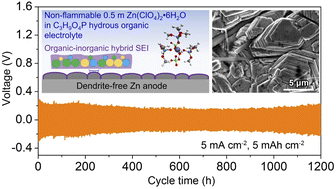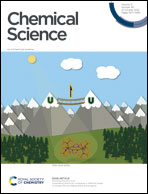Non-flammable, dilute, and hydrous organic electrolytes for reversible Zn batteries†
Abstract
Rechargeable Zn batteries hold great practicability for cost-effective sustainable energy storage but suffer from irreversibility of the Zn anode in aqueous electrolytes due to parasitic H2 evolution, corrosion, and dendrite growth. Herein, we report a non-flammable, dilute, and hydrous organic electrolyte by dissolving low-cost hydrated Zn(ClO4)2·6H2O in trimethyl phosphate (TMP), which homogenizes plating/stripping and enables in situ formation of a Zn3(PO4)2–ZnCl2-rich interphase to stabilize the Zn anode. A dilute 0.5 m Zn(ClO4)2·6H2O/TMP electrolyte featuring a H2O-poor Zn2+-solvation sheath and low water activity enables significantly enhanced Zn reversibility and a wider electrochemical window than the concentrated counterpart. In this formulated electrolyte, the Zn anode exhibits a high efficiency of 99.5% over 500 cycles, long-term cycling for 1200 h (5 mA h cm−2 at 5 mA cm−2) and stable operation at 50 °C. The results would guide the design of hydrous organic electrolytes for practical rechargeable batteries employing metallic electrode materials.

- This article is part of the themed collection: 2022 Chemical Science HOT Article Collection


 Please wait while we load your content...
Please wait while we load your content...